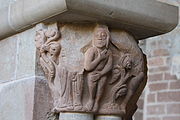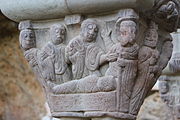Royal Monastery of San Juan de la Peña
The Royal Monastery of San Juan de la Peña located in Botaya, southwest of Jaca, Huesca, Aragon (Spain), was the most important monastery in Aragon in the early Middle Ages. A good number of kings of Aragon were buried in its Royal Pantheon. It is part of the Aragonese way of the Camino de Santiago. Its enclave is extremely unique.
History and legend
Legend has it that a young nobleman named Voto (in some versions, Oto) came hunting through these places when he sighted a deer. The hunter ran after the prey, but it was elusive and upon reaching Mount Pano, he fell off the precipice. Miraculously his horse landed gently on the ground. Safe and sound at the bottom of the ravine, he saw a small cave in which he discovered a hermitage dedicated to San Juan Bautista and, inside, he found the corpse of a hermit named Juan de Atarés. Impressed by the discovery, he went to Zaragoza, sold all his possessions and together with his brother Félix he retired to the cave, where they began a hermitic life.
This would be the beginning of the Monastery that Don Miguel de Unamuno wrote about:
...the mouth of a world of spiritual rocks clothed in a forest of legend, in which the Benedictine monks, half hermits, half warriors, would see to spend the winter, as they trampled the wild bosoms of flesh and blood, out of the woods, bears, wolves and other wild animals.
These mountains were inhabited shortly after the Muslim conquest, when the castle of Pano was built, destroyed in the year 734. The legendary origin of the Kingdom of Aragon also finds its own history in the cave monastery of San Juan de la Peña, when the Christian warriors gathered together with Voto and Félix decide by acclamation to name Garci Ximénez their leader who will lead them to the battle to reconquer the lands of Jaca and Aínsa, this place where the miracle of the cross of fire on the Sobrarbe holm oak occurred.
García Íñiguez and Galindo Aznarez I, Count of Aragón, reigning in Pamplona, began to favor the Monastery. King García Sánchez I granted the monks the right of jurisdiction, and his successors up to Sancho el Mayor continued this policy of protection. There he spent his first years San Íñigo. In the reign of Sancho Ramírez de Aragón he acquired his greatest role, becoming the pantheon of the kings of Aragón.
The fires of 1494 and 1675 were devastating. As a result of the last of them, the New Monastery was built. The Old Monastery was declared a National Monument on July 13, 1889 and the Modern Monastery on August 9, 1923. The restoration was directed by the Aragonese modernist architect Ricardo Magdalena.
Construction of the monastery
Probably some kind of monastery existed before the XI century, but the most important construction began in 1026 by initiative of Sancho the Greater of Pamplona. In the year 1071 King Sancho Ramírez ceded the existing complex to the Cluniac monks and favored its reform. At this time, the complex that remains today, to a greater or lesser extent, is erected. The Benedictine reform of Cluny could not avoid the construction of a cloister that would be completed well into the XII century.
Cloister capitals
At the end of the XI century, there are a set of capitals influenced by Jaca in the cloister with themes of fantastic animals and some motifs geometric and vegetal where the roleos stand out. A second group, made up of twenty capitals, was commissioned in the last third of the XII century from the so-called master of Saint Juan de la Peña, anonymous author, also known as Master of Agüero, probably to replace a previous one. The small enclosure offered a diaphanous enclosure in the form of arcades separated by columns. The arches were finished off with borders with the typical jaqués taqueado.
|
The Master develops a program on biblical scenes where the Announcement to the shepherds, the Nativity, the Annunciation, the Epiphany, the Baptism and Circumcision of Jesus, the Last Supper, episodes about Cain and Abel, Creation appear among others of Adam and Eve, as well as their disapproval and subsequent condemnation to work. Surely Agüero's master only made the capitals for two wings of the cloister, since at the end of the XII century the monastery entered into Frank decay. The iconographic program posed by the 26 capitals that we preserve seems to focus on Salvation through Faith, choosing the most significant episodes for it.
They work with bas-reliefs, almost all of them dominated by a highly accentuated horror vacui that causes contortions in some figures that exceed the frame itself, sticking out an arm as in the scene of Jesus and the Apostles. The gestures are exaggerated, almost theatrical, accentuating the eyes and mouth, and conferring narrative to the scenes. As for the shapes, they are subjected to geometric schemes that dominate from the configuration of the face or the folds of the cloth, to the movements of horses or the same water that is poured from one jug to another.
Royal Pantheon
On the top floor is the Royal Pantheon. Some of the monarchs of Aragon and Navarre were buried in it for five centuries. Its current appearance dates from the 18th century century.
In San Juan de la Peña, the kings of Aragon were entombed in stone tombs placed in three superimposed orders, from the rock outwards, presenting only the feet of the coffin. The royal pantheon occupies the premises of the old sacristy of the upper church, which dates from the 11th century; It was reformed by Carlos III in 1770, following the instructions of Don José Nicolás de Azara and the Count of Aranda, who wanted to be buried in the atrium. The reform only affected the decoration, leaving the tombs in the same place; A wall was erected in front of them on which bronze plates were placed with the corresponding inscriptions, a profusion of stucco and marble was distributed throughout the room, placing on the border wall some medallions with reliefs that represent scenes of legendary battles.
It houses the remains of some Navarrese monarchs who reigned in Aragon, of the first Aragonese counts and of the three initial kings of the Ramirense dynasty, Ramiro I, Sancho Ramírez, Pedro I, together with their wives.
Cataloging
In 1889 it was granted the title of National Monument, which in 1920 was completed with the declaration by King Alfonso XIII as a National Site. Already on February 2, 2004, the Government of Aragon completes its declaration as an Asset of Cultural Interest with the protection of the monastic complex and its surroundings.
Monastery Archive
Most of the documentary collection of the Monastery was transferred to the National Historical Archive of Madrid, where it is located in the Clergy section. Considering the published works, the documentation is divided into three large groups:
- Older texts, between 507 and 1064, which are collected in the Cartulario de San Juan de la Peña.
- Documents dated between 1064 and 1194.
- Documents dated between 1195 and the end of the centuryXV.
The Holy Grail
According to the Spanish legend about the Holy Grail, it remained in the monastery, after passing through various locations such as the Yebra de Basa cave, San Pedro de Siresa monastery, San Adrián de Sásabe church, San Pedro de la Royal seat of Bailo, the Cathedral of Jaca, from 1071 to 1399.
Since the beginnings of the Kingdom of Aragon, this place was considered of capital importance because both kings and nobles were buried in pantheons within its walls. This reality is reflected in the cameras that the monastery currently shows and in the different excavations that have been carried out in the current old monastery. The presence of the Holy Chalice within its walls responds to a decision to transfer the relic from the Cathedral of Jaca to the same monastery because it was there that a mass with the Roman rite was celebrated for the first time in the Kingdom of Aragon. In 1399, King Martin I asked the abbot of the monastery for the sacred vessel on three occasions. He was transferred to the chapel of San Jorge in the Aljafería palace in Zaragoza, where he stayed for more than twenty years. On March 18, 1437, it was deposited together with practically the entire reliquary of the House of Aragon in the Cathedral of Valencia.
The first place in Spain where it is celebrated with the Roman rite is in the Kingdom of Aragon in the monastery of San Juan de la Peña, on March 22, 1071, during the stay of the Holy Chalice in the monastery and afterwards it becomes official in the rest of the kingdom, replacing the Mozarabic rite.
Contenido relacionado
Convent of San Marcos (León)
Frederick William IV of Prussia
27th century BC c.






